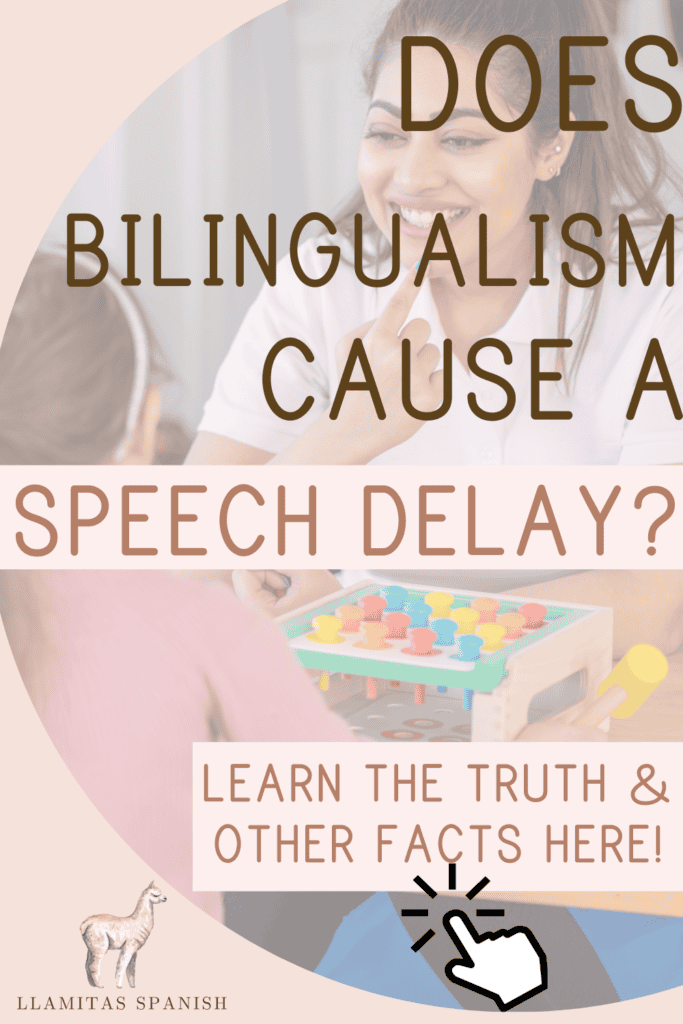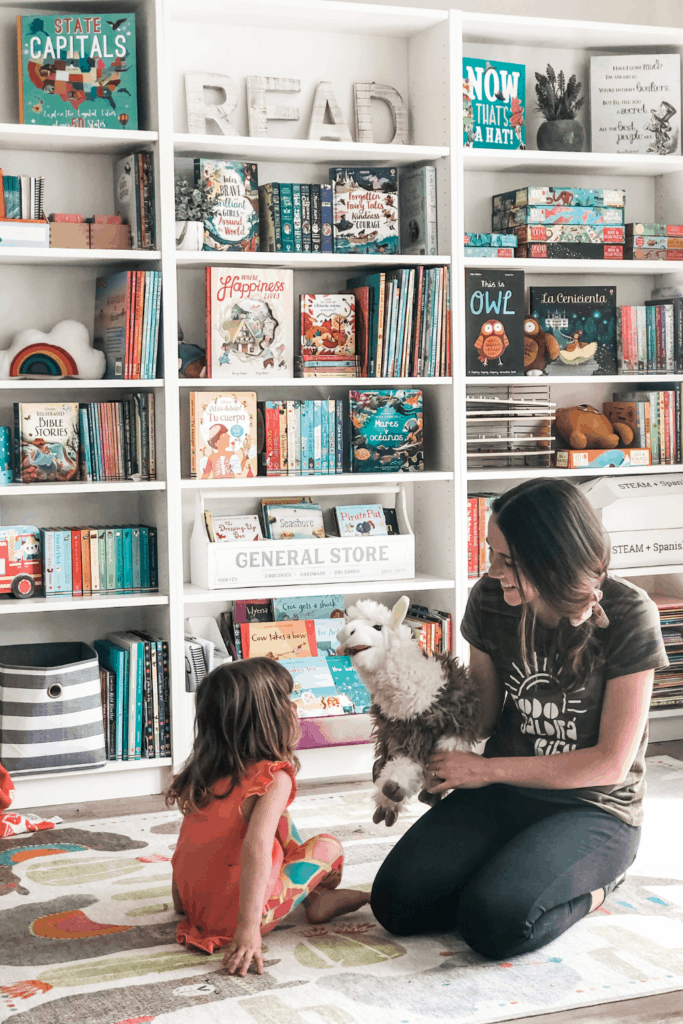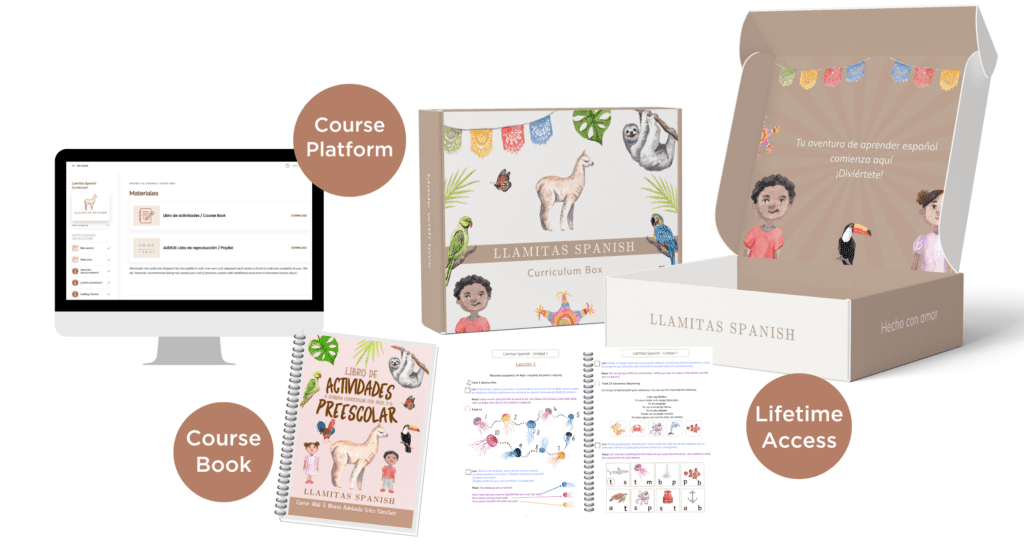In this post: We debunk 10 common myths and misconceptions about raising bilingual children.
More and more families in the USA are making the choice to raise their children as bilingual or multilingual speakers.

This post may contain affiliate links.
Our Llamitas Spanish® Curriculum has gained widespread popularity, and thousands of parents are subscribing to our site to take advantage of our learning resources to help their child’s Spanish language education get off to a great start.
What is Bilingualism?
Bilingualism simply refers to the ability to speak two languages. The level of fluency and proficiency in each language can vary, as can the use of the two languages, based on the child’s daily circumstances and how many opportunities they have to actively use each language.
Basically, there are two ways to raise bilingual children:
- Simultaneous Bilingualism is when an individual has meaningful, significant exposure to two languages from birth. In this case, the child’s exposure to both languages is equal.
- Sequential Bilingualism occurs when a child is exposed in a significant and meaningful manner to a second language, beginning at the age of 3 or 4, once they are already effectively speaking their first language. These children are referred to as second-language learners in the U.S.
The process of language development is different in each circumstance, but in both cases, the benefits of growing up bilingual include enhanced cognitive abilities, increased focus and attention, and a greater ability to multi-task in comparison with their monolingual peers, according to a guide published by the U.S. Department of Education.
Related Post: The Benefits of Raising Bilingual Children
Table of Contents
Myth 1: Most People are Monolingual
This is absolutely false and there are statistics to prove it! In fact, 43% of the world’s population is bilingual, and 13% is trilingual. Bilingualism is not a rare thing, and in fact, in many countries – such as Canada for instance – bilingualism is a normal part of the culture and daily life.
The myth of a monolingual majority is largely based on the populations in English-speaking countries such as the United Kingdom, Australia, New Zealand, and particularly, the United States, where only 25% of the general population is bilingual.
But even within the U.S., in certain areas such as Florida, Texas, and California, the incidence of bilingualism is much higher. For example, in the city of Miami alone, 74% of the population speaks a minimum of two languages. In New York City, 48% of the population is bilingual, and in greater Los Angeles, 42% of residents speak Spanish as well as English.
Plus, the rate of bilingualism is growing, as more and more families discover the benefits of raising bilingual children! In New Jersey, the bilingual population increased from 25% to 30% in 10 years, while in the state of Maryland, the rate of bilingualism rose from 14% to 19% in that same time period.
¿Por Qué Aprender Español?
Of all foreign languages spoken in the U.S., Spanish is the language most frequently spoken at home, and the one that most non-native-speaking parents choose to teach their children. It makes sense, given that Spanish is the official language in 20 countries, is the 4th most spoken language in the world, the second most spoken language in the U.S., and is spoken by 548 million people around the world!
From a business viewpoint, as our world becomes smaller, bilingualism is an advantage that opens doors and opportunities! More and more companies are seeking bilingual employees to help them reach wider markets in a global business environment.
From a personal viewpoint, I love being able to interact with native Spanish speakers I meet running errands, at the park, in our neighborhood, and at our church. It is a true joy to be able to communicate with (nearly) everyone here in San Diego!
To help make your child’s learning journey more fun, our FREE Spanish Resource Library provides you with printable, screen-free materials, as well as music, games, and much more! We update the content regularly to help your little linguist enjoy every moment of learning Spanish!

Myth 2: Bilingualism Causes Speech Delays
This myth is easily debunked by the sheer amount of research done on the subject that concludes that bilingualism supports greater cognitive abilities in children: the prefrontal cortex (which directs our attention) actually produces stronger connections and brain activity in bilingual children in comparison to their monolingual counterparts.
This TED Talk which reveals a non-invasive, completely safe experiment that compares the brain activity in monolingual and bilingual babies’ brains is truly eye-opening! Skip to 3:30 to see this part of the video, but I recommend watching the whole 17 minutes. It’s fascinating!
The Silent Period
The first stage of learning any new language is known as “The Silent Period.” This is the period during which a student begins to take in the new language, but does not yet have the confidence to speak it. This is not speech delay.
Related Post: Silence is Golden: What is the Silent Period in Second Language Acquisition?
This period can last several weeks or longer, depending on each child’s ability to integrate the new language into their natural form of expression.
During this period, the student will begin to speak short words and sentences in the new language, although the emphasis at this stage of the learning process will still be on hearing the new language, listening and absorbing its sounds and syntax.

During this “silent period” progress may be hard to see, but it IS happening. Language must first be acquired before it can be produced, and this period is unique for each child. Other factors, such as having older siblings who are already active speakers, are can also influence this stage of the learning period.
During the “silent period” it will help to have the child hear the Spanish language as much as possible. Some great ways to increase input this way is by listening to our popular songs and nursery rhymes in Spanish and completing structured curricula to support input.
Myth 3: Bilingualism Causes Confusion in Children
When children are acquiring two languages, it is very common for them to mix the two at an early age until they are old enough to differentiate between them. This is not a sign of confusion. In fact, it is actually a sign that the child’s vocabulary is expanding in both languages, and a testament to their ability to switch easily and translate concepts on the fly between the two.
Code Mixing
“Mommy, this car is rojo. It goes super rápido!”
This is an example of ‘code mixing’ in which a child switches between two languages in the same conversation, and is a very common characteristic in bilingual children. Ask any parent raising bilingual kids and they will most likely tell you it happens in their home. Rest assured, it is NOT confusion and can actually be an advantage.
While still little, children have a very limited vocabulary to express themselves with. Sometimes, they will recall the word they need in just one of their two languages and jump to use it to express what they want to express in that moment.
As this process develops over time, your children will actually have double the vocabulary available to them, compared to their monolingual friends. That’s a huge advantage!
How to Respond to Code Mixing
Firstly, understand that this is just a temporary situation and should not be corrected, since it isn’t actually a problem. Children thrive on affirmation, so praise your child for their use of language, and even for their ability to mis their two languages, then respond using just one of the languages:
Back to the previous example. My response would either be:
“Wow! Yes that car is red and it goes very fast, doesn’t it?”
Or I might say:
“¡Es verdad! Ese carro es rojo y va muy rápido.”
Mixing languages and using words from both languages actually comes pretty naturally for bilingual speakers, and parents can encourage their children to blend languages, as this will enhance their ability to translate and code-switch between them, while supporting fluency in both.
But it is also important to spend a few hours each day speaking each language exclusively, so your child can easily distinguish between the two languages in order to speak each language correctly.
Family Language Strategies
Consistency is key for many families. For example, in many cases, all members of the family agree to use the same terms when naming certain everyday objects, particularly while your child is still very young.
In this strategy, it is generally recommended that both parents choose the same name for the same objects and stick to those consistently. This helps the child to develop a sense of continuity as they learn.
Yet, in other bilingual families, particularly when only one parent is fluent in the child’s second language, it may work to have each parent speak to the child in a different language, and the child learns to code-switch between the two parents.
OPOL (One Parent One Language) is a strategy that many bilingual families use, and it works especially well with parents who are native speakers in different languages. For example, an American mom who speaks English to her kids and a Mexican dad who speaks Spanish to them.
Minority Language at Home is another strategy that many families use to ensure that both languages are being used with sufficient frequency.
For example, if a child lives in the U.S. and goes to an English-speaking school, the parents may choose to adopt a Spanish at home policy to create greater exposure to the Spanish language and ensure that language isn’t lost. Many native-Spanish-speaking families are now adopting this strategy.
For a complete guide and step-by-step plan for making a Family Language Plan, download our eBook!

Make Language Learning a Part of Your Daily Life
Whichever model you decide to apply, your biggest challenge will probably be finding enough time each day to adequately expose your child to both languages. Essentially, the best way to achieve this is for your child to be hearing that second language regularly.
You can incorporate language learning into your child’s daily activities, using the second language to reinforce daily habits, such as tooth-brushing or getting dressed.
Repetition is the key to learning a new language, so try to repeat words and phrases as often as possible, until your child becomes fully familiar with them.
In either language, it’s always best to start with simple, kid-friendly words and phrases, and throw in some non-verbal communication to help your kids more easily learn the meaning of new, unfamiliar words (comprehensible input).
Expand upon the words and phrases that your children are already using. Repeat what your child says and then add an extra word or phrase to help them expand their thought process. For example, if a child says the word “más” to request more juice, respond with the phrase “más jugo” and repeat it a few times while encouraging the child to also repeat it.
You can even choose a Spanish mascot to encourage them to speak the target language!

Encourage your child’s use of their second language by setting an example and using the language yourself, rather than demanding that they speak it on their own. Each child is unique and learns at their own rate.
Most bilingual children will naturally express a preference for one language over another around certain people or in certain circumstances. For example, in many native-Spanish-speaking families, bilingual children often learn to immediately switch into Spanish when visiting their Abuelos.
Always encourage your child to communicate openly with you in whatever language they feel most comfortable at the moment. If you see your child struggling to answer a question or finish a sentence in Spanish, you can say simply, “just say it in English until you remember” then provide the Spanish word or phrase as a reminder.
Myth 4: Only Very Young Children Can Be Raised Bilingual
While there is certainly a critical period between birth and 5 years old, during which children acquire languages more naturally – and this early childhood period is indeed ideal for beginning language studies – the myth that older children can’t learn new languages is nothing short of absurd.
People’s lives and circumstances change continuously throughout life, and a consequence of life’s natural evolution is often the need to acquire a new language, at any age, be it for reasons of international migration, education, work, or simply the desire to study and enjoy the literature and films of a certain culture.
People are constantly learning new languages as we move through life at any age, particularly as air travel has made our world smaller and more accessible!
The Window of Opportunity
Nevertheless, there is a real window of opportunity that parents can take advantage of if they want to facilitate language acquisition skills for their children beginning in early childhood.
It is generally true that “toddlers are like sponges,” taking in everything in their environment almost subconsciously, and that ability to subconsciously learn a language almost effortlessly gradually diminishes as we get older, as the brain changes. During this early childhood period, children learn while not even realizing that they are learning!
As the child grows, they become more aware of their learning process, and the process becomes something conscious that they must put effort into.
This may require more focus and concentration, and the child may even experience resistance at times! But with consistency, repetition, and encouragement, most children easily get past those moments of temporary resistance and enjoy the process of learning, as children naturally do.
Myth 5: Only Native Speakers Can Raise Bilingual Children
This myth piggybacks upon the previous one and is equally untrue. There are thousands of parents who have learned a second language as an adult, and then raised their children in that language instead of in their native tongue.
Think of any American in Europe who has raised their child in French, Italian or Spanish, or any Mexican family in the U.S. whose child is required to speak English every day at school. It is not essential for parents to be native speakers of a language in order to teach that language to their child.
In fact, you can take me for example! I am a Brit, living in the States, married to an English-speaking American. I began to study Spanish at age 18 and became fluent by the age of 21, after spending a year teaching English in Seville, Spain and studying Spanish at St. Andrew’s University in Scotland.

In our family, since both parents are non-native speakers, it just takes a little bit more effort and intentionality than it might for a native-speaking family. But we are successfully raising bilingual children through intentional daily input!
Eventually, these baby steps grow into giant leaps- which we are seeing now that we are a few years down the road.
Related Post: How to Raise a Bilingual Child
Myth 6: Learning a New Language is too Hard for Most Kids
There is absolutely no evidence to support the myth that learning a new language poses excessive cognitive challenges for children.
Learning a new language does not overwrite the linguistic abilities that the child has already developed. Instead, bilingualism enhances the child’s ability to process linguistic information in a manner that is more complex, allowing them to easily code-switch between languages.
Actually, bilingual children tend to do quite well in school, and achieve higher than average IQ scores on cognitive and giftedness assessments. Many researchers are convinced that bilingualism provides significant cognitive advantages for most children, improving their ability to learn overall.
One potential explanation for this is the fact that bilingual children develop logical thinking skills, simply by recognizing that a single concept can be expressed in different languages, using different terms. This gives them a learning advantage when compared with their monolingual peers.
Myth 7: Children with Certain Disabilities Can’t Be Bilingual
This myth was debunked in 2019 in a report published by the National Institute of Health which states that in the United States, 12 million children speak a primary language other than English at home.
The study notes that, within this bilingual population, 1 in 4 children – or about 3 million kids – have autism spectrum disorder (ASD) and are growing up within a bilingual home environment. This goes to show that kids with autism can indeed be raised bilingual, and many are already enjoying this benefit.
Children with Down’s Syndrome can also grow up bilingual, and in fact, they can acquire language skills at the same rate as their typically developing peers.
A recent study published in Down Syndrome News and Updates found that, while bilingual children with Downs use shorter phrases and sentences than typically developing children, when compared with neurotypical kids at the same stage of language development, the Downs kids were successfully progressing at the same rate in vocabulary acquisition in both languages.
With Downs children, parents can expect a typical delay in mastering longer sentences and grammatical structures in both languages, which is a characteristic of Downs Syndrome, but language acquisition can continue and progress with great success.
Myth 8: Bilingualism Causes Stuttering or Speech Impediments
This myth originates from a study conducted in the 1930s (Travis, et. al, 1937) that concluded that bilingual speakers have a higher incidence of stuttering than monolingual speakers (2.8% vs 1.8%).
That study was since discredited, however, by more in-depth studies carried out by scientists in the 21st Century who refuted the validity of the Travis study due to deficiencies in the research methodology used at the time (Bloodstein & Bernstein Ratner, 2008; Van Borsel, 2011; Van Borsel et al., 2001).
Because years of research have established that stuttering has numerous causes, these contemporary scientists determined that it would have been essential to consider other factors that might have contributed to the stuttering prevalence of bilingual subjects in the Travis study.
They were particularly concerned that many factors that have been established as conditions that typically contribute to stuttering, such as genetics or hereditary speech impediments, emotional trauma and/or anxiety, certain medical conditions, and/or trauma caused by the immigration process, and the difficulty of adapting to a new environment were not considered.
Without considering these factors, which are known to influence speech development in children, it is impossible to conclude that bilingualism was the sole factor that contributed to the prevalence of stuttering in bilingual subjects in the Travis study, which largely nullifies the results of that study.
In many cases, stuttering is simply a normal aspect of language development (particularly in male children) that naturally clears up around the age of 5. Stuttering is often a natural reaction to the challenge of pronouncing new and unfamiliar words or phrases.
In the case of bilingual speakers, the stuttering typically happens in both languages, and particularly when attempting to pronounce words or phrases that the child has not yet learned.
If your child continues to stutter or stumble over the same words or phrases for a period of over six months, it might be wise to take them to a speech pathologist to determine causes.
Myth 9: Bilingual People are Equally Fluent in Both Languages
Being bilingual doesn’t come with rules, and it doesn’t require being completely fluent in both languages. The goal in learning a new language is communication, and if your little linguist is able to do this in two languages, you’ve achieved a major goal, even if they have more proficiency in one language than another.
In fact, you will likely find that your child does develop a preference for one language over another, as most bilingual speakers of any age typically have a “dominant language” that they’re slightly more proficient in.
Language proficiency responds to environmental factors, and people are naturally more fluent in the language they speak most frequently. But proficiency is not a static thing, and a person’s language preference or proficiency may also change as their life circumstances, education, and peer group evolve, so your child’s preference for one language over another may be only temporary.
And don’t worry if you speak to your child in one language and they answer in the other. As long as communication is happening, proficiency is improving.
Myth 10: You have to Live in a Spanish-Speaking Country to Speak Spanish Fluently
This is absolutely untrue, as evidenced by the number of people in the U.S. who are fluent in Spanish and have never set foot in Spain or Latin America! But being bilingual does mean that you may also be bicultural, or at least have an appreciation and respect for other cultures.
Raising Global Citizens
Raising global citizens is an important and valuable part in the journey of raising bilingual children. It’s healthy to expand their horizons and encourage their curiosity and engage with their (many) questions!
Find fun ways to enhance their interest in other countries and cultures by taking them to museums, trying different cuisines, playing music from different cultures and instruments and READING. There are so many lovely diverse children’s books.
In the meantime, an excellent book about raising bicultural children is Arroz con Pollo and Apple Pie by author and bilingual parenting expert, Maritere Rodriguez Bellas. I highly recommend it and love everything she shares on her website and Mamás 411 Podcast that supports both non-native and native Spanish speaking families.
Llamitas Spanish Curriculum

Finally, if you are ready to raise a bilingual and biliterate child, our Llamitas Spanish® curriculum is for you! We are passionate about providing authentic and beautiful learning materials for children.
Discover more in our curriculum shop and let us help you jumpstart your Spanish learning journey today!
